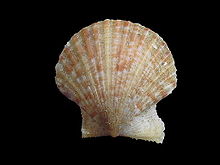The Queen Scallop!
By Connie Gould

Introduction
Classification:
Kingdom: Animalia
Phylum: Mollusca
Class: Bivalvia
Order: Ostreoida
Family: Pectinidae
Genus: Aequipecten
Species: A. opercularis
Introduction
A. opercularis, or, by its common name, the queen scallop, is most commonly found at the bottoms of seas and oceans, except in rocky areas. They can live at depths of 1,312 feet, but are most commonly found at depths of about 130 feet. They are found in the Mediterranean Sea and East Atlantic coast, and are commonly found in bodies of water surrounding areas from Norway to the Cape Verde Islands, and are raised on experimental farms in Spain, France, and the U.K. As a species, the queen scallop is not considered threatened or endangered.
Anatomy
The queen scallop possesses two laterally located valves, or shells, characteristic of their class. The valves are flat and round, and 20 ribs extend out from the umbo. Small, winglike extensions that are unequal in size are found on either side of the umbo. The color of their shell varies; the color can be either spotted or solid, and white red and orange are the most common colors. The right valve is typically lighter in color than the left, and the inside of both valves is white. The edge of the mantle possesses many sensitive tentacles that have eyes. They are typically around 7 cm in size, and therefore are one of the smaller species of scallop that is exploited by humans.


Form and Function
The queen scallop’s diet consists of plankton and other tiny plants and animals floating in the water. They are suspension feeders, which means they depend on ciliary currents produced by their gills to get their food. Gland cells on the gills secrete large amounts of mucus, which captures food particles suspended in the water. Ciliary tracts then move the particles to the mouth. In the stomach, a crystalline style keeps the food particles moving, enzymes for extracellular digestion dissolving off of the rod as it rotates. Particles are then directed to the digestive gland, where they undergo intracellular digestion. The two valves of a queen scallop are located laterally (at the sides), and are held together by a hinge ligament. Adductor muscles draw the valves together. Above the hinge ligament is the umbo, the oldest part of the shell. Their valves are primarily used for protection against predators. Predators include sea stars, gastropods, and cephalopods. Their visceral mass is suspended from the dorsal midline, and they have a muscular foot that connects to the visceral mass. Queen scallops have a three-chambered heart that pumps blood through the gills and mantle for oxygenation. The heart also pumps blood to the kidneys for the excretion of waste. The queen scallop can escape danger by “swimming.” It extends its muscular foot, and blood is pumped into the foot, resulting in a swelling that allows the foot to act as an anchor. Longitudinal muscles contract to pull the scallop forward. Queen scallops are monoecious (hermaphroditic); they start their life as males and their gender changes over time. For reproduction, they release spermatozoids and eggs into the water during mating season, and fertilization takes place.

Impact on the World/Humanity
Queen scallops are of great economic importance. They are raised in commercial fisheries most commonly in countries in western Europe, and are frequently found on the menu in upscale restaurants. They are an important part of the marine food web, as they are eaten by cephalopods, which are also a source of food for humans. The queen scallop’s colourful valves can also be worn as jewelry.
Journal Article Review
The Isle of Man Government’s Fisheries Directorate has earned first place at the U.K. finals of the Sustainable Seafood Awards 2011. The award is of great prestige, as it means that the Isle of Man Queen Scallop Fishing Industry manages to produce world class products while protecting the animal as a species. John Shimmin, minister for the department, said: “It is gratifying to receive this type of recognition of our efforts.” The Isle of Man Queen Scallop Fishing Industry fishes only mature queen scallops, ensuring that the younger stock remains on the seabed, repopulating the waters for future years, and preventing the endangerment and overfishing of the species.
Article Source: http://www.fishupdate.com/news/fullstory.php/aid/14784/Island_Queen_Scallop_Industry_wins_Sustainable_Seafood_Awards_2011.html
Videos
http://www.youtube.com/watch?v=vmi_I8QW5eo
http://www.youtube.com/watch?v=RrCKsch9c1k&feature=related
http://www.youtube.com/watch?v=RyYKZgz7lEw&feature=related
Sources
"Bivalves: Bivalvia - Queen Scallop." Web. 30 Apr. 2011.
Hickman, Cleveland P. "Molluscs." Animal Diversity. Boston: McGraw-Hill Higher Education, 2009. 192-96. Print.
"Queen Scallop." Wikipedia. Web. 30 Apr. 2011.








